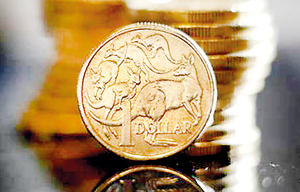Sunday Times 2
Australians suddenly richer as statistician “finds” $338 billion
View(s):SYDNEY (Reuters) – Australians are suddenly a whole lot better off after the government statistician “found” A$325 billion ($338 billion) in share assets previously unrecognized.
The Australian Bureau of Statistics on Thursday released its latest report on household assets which included massive upward revisions to estimates for equity holdings. Total financial assets were now put at A$3.1 trillion at the end of March, compared to the originally reported A$2.77 trillion.

Australian one dollar coins are displayed in this photo (Reuters)
The revision is worth roughly A$14,380 for every one of the country’s 22.6 million people.”This issue incorporates new estimates for households holding of unlisted shares and other equity in other private non financial corporations,” the statistician drily noted.
The value of such equity is now put at A$383 billion at the end of March, compared to the original A$91 billion.
“The Bureau of Statistics has effectively ‘found’ A$325 billion in household wealth,” said Craig James, chief economist at CommSec.
Total financial assets also rose further in the second quarter to stand at A$3.11 trillion by the end of June, up A$76 billion on the same period last year.
No less than A$702 billion of that was held in bank deposits. Australian banks have been competing fiercely for deposits to reduce their dependence on offshore funding, while households have been keen to save more in the wake of the global financial crisis.
Since the end of 2007 the amount of money stashed in bank deposits has climbed by A$260 billion, or almost 60 percent.
“Australians are continuing their love affair with defensive assets such as cash and bank deposits,” said James.
“And it’s not just Aussie consumers, but companies and even superannuation funds,” he added. “Pension or superannuation funds have more than 15 percent of funds in cash and deposits – the highest proportion on record.”
Non-financial companies held A$395 billion in cash and deposits at the end of June, suggesting one reason why lending to businesses has been so sluggish in the last couple of years.
The upward revisions to wealth also mean households do not look quite as stretched when compared to their debts.
The ABS now estimates the ratio of debt to liquid assets was 129.1 percent in March, well down on the original estimate of 170.1 percent.
There have been long-standing concerns that the high debt levels of Australian households left them vulnerable to an economic shock such as a sharp rise in the, currently low, 5.1 percent unemployment rate.
Follow @timesonlinelk
comments powered by Disqus














